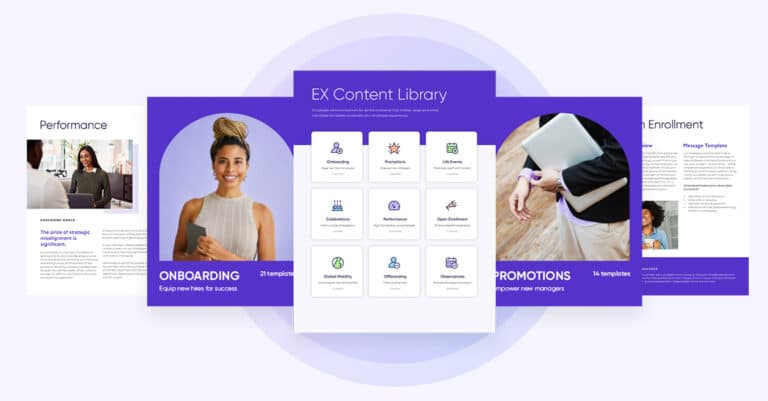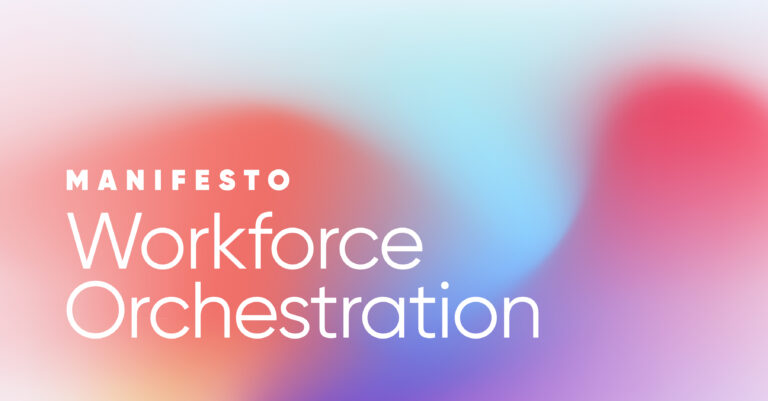Employee communication definition
Employee communication is the sharing of information, ideas, and feelings between employees and managers of a company. It can happen verbally, or electronically, on various mediums such as email, mobile applications, intranets, and collaboration tools. Employee communication is vital for the health and strength of a company. Without it, managers would not be able to properly lead the employees they manage. The more effectively a business can execute an employee communication strategy, the more successful it will be.
Employee communication benefits
Increases employee engagement
Effective employee communication has a direct correlation to employee engagement. When employees receive the necessary information they need to do their jobs efficiently, while also having the ability to offer feedback, they feel more connected, both to the company and to each other, heard, and productive, ultimately making them more engaged in their daily responsibilities.
Maintains workplace harmony
If communication does not flow properly back and forth between employees and managers, it can lead to misunderstandings, bottlenecks, and other issues. All of these problems can create stress and disrupt harmony in the workplace. Clear and transparent employee communication helps to prevent problems and get them resolved quickly when they do occur. This helps to preserve a harmonious workplace.
Helps manage a diverse workplace
Inclusive communication allows for employees of different backgrounds, ideologies, and perspectives to come together under one mission and function effectively as a cohesive unit. When everyone feels like their voice is heard and their opinions are valued, companies can truly succeed.
Improves the employee experience
Employee communication goes far beyond simply serving as the means by which employees receive company news. Effective communication elevates the employee experience by giving employees a sense of purpose within their daily responsibilities. When employees feel like they have all of the necessary tools, information, and resources to thrive both in and out of the workplace, holistically, they feel connected, included, and empowered to be their very best at work.

Encourages innovation
Employee communication encourages innovation just as much as it encourages collaboration. When team members can effectively share ideas and information amongst each other, listen to everyone’s perspectives, and truly collaborate as a team, innovation is inevitable.
Increases inter-departmental cooperation
While each department within a company serves a specific purpose and function, they’re all dependent on each other to succeed both individually and as a collective. Therefore, it’s important for departments to be able to communicate with one another for ongoing collaboration and support. When all departments are in sync and working in tandem, companies will flourish. If any single department is cut off from communication and not in sync with the rest, that department, as well as the company at large, can suffer.
How to implement an employee communication strategy
Set clear goals
In order for your employee communication strategy to work, you need to know exactly what you are shooting for. For example, one employee communication goal that you might have is to raise awareness about corporate strategy within your employee ranks so that employees can serve as organic brand ambassadors. This strategy can be very effective because if you can ignite a passion for the mission and vision of your company in your employees, there is a good chance they will spread that vision and passion to people in their lives.
Use a modern and effective employee communication platform
Over the past 10 years, a number of highly advanced and pragmatic employee communication platforms have been created. These platforms allow business leaders and employees to communicate with one another in a way that is highly effective. Firstup, the leading employee communication and engagement platform, supports over 40% of the Fortune 100 in its mission to create more connected, inclusive, and engaged workforces across the world. Due to its ease of use, personalization, and ability to broadcast information to all employees, whether they sit behind a desk or not, you should consider using Firstup to modernize and optimize your employee communication tech stack.
Integrate video and mobile
Both video and mobile communication are extremely important for employee communication in the modern era. This is because most employees would rather watch a video than read text, and because almost all employees carry a smartphone on them both during work and at home. The smartphone is arguably the greatest communication tool ever invented, and your company can take advantage of this tool through communication apps.
Make sure managers are leaders in communication
Managers are the ones who set the tone for employee communication. This means that they need to be the ones initiating communication and leading by example. This can mean providing employees with updates about company strategy, company news, new projects, etc. The more effectively managers can communicate with their employees, the more successful the company is likely to be. Great business leaders are able to unite and inspire their employees through effective employee communication.
How technology can enable better employee communication
There are many ways that companies can use technology to better enable employee communication. For example, your company can use third-party content curation tools to find the ideal content for your employees. You can also use platforms that are capable of live-streaming when your company has events. Livestreaming enables all of your employees to enjoy the event even if they are not at its physical location. Furthermore, your company can also use apps like Firstup that are ideal for communication. With Firstup, all your employees need is a smartphone, and they can be communicated with extreme ease and efficiency. We streamline the entire employee communication process and therefore improve a company’s efficiency overall.
Hyper-personalized comms for every employee
Best practices for successful employee communication
A successful communication strategy may vary by company depending on their size, geographic locations, employee demographics, etc.; however, there are a few universal best practices that apply to every program. One important way to ensure effective employee communication is to empower managers as communication leaders and task them with asking employees for feedback. Feedback is critical because employees will tell you what is and isn’t working, allowing you as a communicator to adjust your strategy as needed based on their feedback. Additionally, your company should take advantage of social media. Encouraging your employees to share stories about their work and their lives on social media helps create a strong culture around the company.
It is also important to have the right mix of content including written content, videos, images, etc. to keep employees engaged. Content should then be broken down to an ideal mix of 1/3 company news, 1/3 industry news, and 1/3 daily life. If you can keep your content mix close to this, it will greatly benefit your business.
Tips and tricks to engage employees with your communications
The best way to engage employees with your communications is to understand their individual needs and meet them where they want to be met. Every employee has their own preferred means of communication, whether it be through email, text, workplace collaboration tools, etc. As an employer, it’s essential to recognize this and adapt accordingly. Workplace communication apps like Firstup host a number of great features that allow employers to effectively communicate with their workforce while keeping employee needs top of mind. For example, Firstup has personalized news feeds, content translation, broadcasts, newsletters, and more to deliver communications via employees’ preferred channels. As you continue to transform your strategy, it’s crucial to encourage ongoing feedback to track what is and isn’t working so that you can adjust accordingly. Likewise, it’s equally as important to encourage two-way communication with employees in order to foster a culture of sharing, increase connectedness, and keep employee morale and confidence in the company high.

Ted is a company that provides informational talks and has a variety of guest speakers. This company excels in communication by keeping meetings short. The company did research that revealed that the ideal meeting length is 10-18 minutes due to the limitations of the human attention span. So, it now limits its meetings to a maximum of 18 minutes. This style of short meetings has helped to boost the success rate of the company’s employee communication efforts.

Netflix is one of the world’s leading video content streaming providers. Netflix is also known for thinking outside of the box. So, it’s no surprise that Netflix came up with an innovative solution for a communication problem that it was having. The challenge that Netflix was facing was that managers, executives, and board members were taking too much time to make decisions and communicate with each other. To solve this problem, Netflix decided to only have its board members observe meetings and communicate with other leaders of the company through online memos. The company discovered that this was an extremely efficient way to communicate, and they credit the style of communication for being partly responsible for their success over the last few years.

Cumberland Farms operates over 560 convenience stores in the United States. One of the reasons why this company is so successful is because it focuses on providing an excellent employee experience. Cumberland Farms believes that when employees are happy, they naturally provide a better experience to customers, or as they call them, “guests.” In order to improve employee experience, Cumberland Farms started using Firstup. With the help of Firstup, Cumberland Farms was able to streamline employee communication, which is crucial in their fast-paced industry. They created newsletters to help employees stay up-to-date with everything happening in the company and they made it very easy to share content internally and via social media. Cumberland Farms was able to transform its strategy for the better by using Firstup for employee communication.
Employee communication stats to pay attention to
Over the past decade or so, a large number of alarming statistics have emerged regarding employee communication. Being aware of these statistics can help your company to better understand the importance of employee communication and some of the most valuable information about this key business area. Here are the statistics:
- During the pandemic, the percentage of remote workers jumped from 31% to 70%
- 60% of companies don’t have a long-term strategy for internal communication
- Only 13% of companies use their intranets on a given day
- 74% of employees feel they are missing out on company news
- 72% of employees feel they don’t have a proper understanding of the company’s strategy
- Employee productivity increases by 25% when employees feel connected
- Employees are 75% more likely to watch a video than read text
Due to the fact that so many people are working from home now, it is extremely important that all companies have employee communication under control. It has literally never been more important for businesses to communicate effectively. People can’t just walk up and talk to one another anymore at a lot of companies, so businesses need to adapt. Using effective employee communication apps is one of the best things a company can do to keep everything organized and keep information flowing efficiently throughout the company. Companies that fail to adjust to remote work environments will most likely lose ground to their competitors who do.
Although the pandemic has created a lot of challenges for businesses there is some good news. For example, 66% of employees say that their productivity actually improves when they work remotely. This means that you might actually be able to get more out of your employees while they are working from home as long as your employee communication is done correctly. So, despite all of the hardships of the pandemic, try to find the opportunities that are available as a result of the current work situation and make the best of it.
Don’t take it from us
Hopefully, by this point, you understand that employee communication is crucial to business success across any industry. A poorly executed employee communication strategy can cause employees to endure an unsatisfactory work experience, leading to a whole host of problems with morale, productivity, and even in some cases, customer satisfaction. Your company should emphasize its focus on providing the best possible communication to employees so that they can stay well informed with everything they need to perform their jobs at the highest level. Don’t simply take our word for it, though. Here is a collection of statements on employee communication from some of the world’s most influential business leaders.

“There are only three measurements that tell you nearly everything you need to know about your organization’s overall performance: employee engagement, customer satisfaction, and cash flow… It goes without saying that no company, small or large, can win over the long run without energized employees who believe in the mission and understand how to achieve it.”
—Jack Welch, former CEO and chairman of General Electric
“To win in the marketplace you must first win in the workplace.”
—Doug Conant, founder and CEO of ConantLeadership, former president and CEO of Campbell’s Soup


“Understanding your employee’s perspective can go a long way towards increasing productivity and happiness.”
—Kathryn Minshew, CEO and co-founder of The Muse
“Early in my career, one of the first business lessons I learned was this: It’s impossible to win the hearts and minds of people unless you clearly establish goals and values and reward people if they act in a way that leads to the fulfillment of those objectives. It quickly became clear to me that if you want to make sure your customers are treated well, you have to make sure you treat your employees well and recognize their efforts.”
—Robert Salerno, CEO of Avis


“Employee engagement is the art and science of engaging people in authentic and recognized connections to strategy, roles, performance, organization, community, relationship, customers, development, energy, and happiness to leverage, sustain, and transform work into results.”
—David Zinger, employee engagement expert
As you can see from the quotes above, employee communication is highly valued by some of the top leaders in business. Great business executives understand that communication cannot be neglected if the company is to perform at the highest possible level. A company is, after all, a team, and every team, from the Boston Red Sox to Apple Inc., needs effective communication to succeed.
In conclusion
Unfortunately, many business leaders fail to realize the importance of effective employee communication. Oftentimes, business leaders prioritize other areas of the company such as marketing, sales, manufacturing, product development, or customer service instead of focusing on how to improve communication internally. However, when internal communications progress, nearly every area of a business tends to also advance. So, improving internal communications is actually one of the best things a company can do to improve other areas of the business.
Simply knowing that employee communication is important is not enough. In order to benefit the most from an employee communication strategy, you must develop a strategy with your specific business needs, goals, and pain points in mind.
If you want to improve employee communication at your company, then you can try to create a custom solution just like Ted and Netflix did. Likewise, you can also use a high-quality employee communication application just like Cumberland Farms. Ever since Cumberland Farms started using Firstup, their company’s employee communication has been better than ever. Many companies can benefit from implementing Firstup and other employee communication tools to better streamline, modernize, and measure communications.
In the remote work business climate that we are in due to the pandemic, your company cannot afford to neglect employee communication. It may be uncomfortable to start making changes to your existing communication strategy, however, these growing pains can be well worth it. Just think about how much your company would benefit even if your employees had a ten percent increase in workplace satisfaction. Improved employee communication can help to bring about such changes.
So, if you have been thinking about making improvements to your employee communication strategies, then there is no time like the present to get started. Improving communication for remote workers is especially important due to the pandemic. Although remote work has a number of benefits like increased productivity and increased convenience for workers realistically it may continue long after the pandemic is over. Therefore, it makes sense to optimize your employee communication methods for remote workers now, so that you can benefit from your improvements in the long run.
Deliver a hyper-personalized employee experience at scale
Download PDF









